Guides • Perfecting your Craft
Posted on Feb 07, 2022
Types of Poems: 15 Poetry Forms You Need to Know
About the author
Reedsy's editorial team is a diverse group of industry experts devoted to helping authors write and publish beautiful books.
More about the Reedsy Editorial Team →Martin Cavannagh
Head of Content at Reedsy, Martin has spent over eight years helping writers turn their ambitions into reality. As a voice in the indie publishing space, he has written for a number of outlets and spoken at conferences, including the 2024 Writers Summit at the London Book Fair.
View profile →Poetry is an art form that, for much of its history, has been defined by how it adheres to (or defies) its own tradition. And part of that rich tradition is the poetic forms that have been championed by each generation's leading writers. To understand where poetry is going next, readers and writers should ideally know where poetry has come from.
In this Reedsy guide, we will examine what it takes to write and publish poetry. But lest we run before we walk, we should first become intimate with the many faces of the great spoken art...
In other words, here are 15 types of poems everybody should know:
1. Sonnet

The invention of the sonnet is first accredited to the thirteenth-century Sicilian poet Giacomo da Lentini, who crafted the form as an ideal way of expressing ‘courtly love’. This poetry form was typically meant to express a ‘forbidden love’ in the court (think ‘noble lady falls in love with the squire’) and it was a genre in itself at the time.
Modern variations are closer to Seamus Heaney’s Glanmore Sonnets, in which he takes the drama expected of a sonnet and plays on that by writing about the mundane.
The two most common sonnets are named for their best-known practitioners: William Shakespeare and the 14th-century poet, Petrarch. While both of these are fourteen lines long, they come with different rule sets:
What makes a Shakespearean sonnet?
Structure: Fourteen lines of iambic pentameter.
- Three quatrains (4 lines), followed by a couplet (two lines).
- The final couplet presents a volta (AKA a thematic twist) or conclusion.
Rhyme scheme: ABAB CDCD EFEF GG.
Similar forms in other cultures: Onegin stanza / oneginskaya strofa (Russian), Quatorzain (French, archaic).
What is iambic pentameter?
Iambic pentameter consists of five iambic ‘feet’ — stressed syllables followed by unstressed syllables — sounding something like:
Now IS the WIN-ter OF our DIS-con-TENT
It was Shakespeare's favored meter, and, spoiler alert, iambic pentameter crops up in a lot of other poetic forms!
What makes a Petrarchan sonnet?
Structure: Fourteen lines, split into two stanzas, in iambic pentameter (traditionally).
- First stanza: eight lines (an octave) asking a question or posing an argument
- Second stanza: six lines (a sestet) answering that question.
- The volta arrives between the eighth and ninth lines
Meter: Iambic pentameter (traditionally).
Rhyme scheme: ABBA ABBA CDECDE
Similar forms in other cultures: Onegin stanza / oneginskaya strofa (Russian), Quatorzain (French, archaic).
Shakespearean example: "Sonnet 18" by William Shakespeare
Shall I compare thee to a summer’s day?
Thou art more lovely and more temperate:
Rough winds do shake the darling buds of May,
And summer’s lease hath all too short a date;
Sometime too hot the eye of heaven shines,
And often is his gold complexion dimm'd;
And every fair from fair sometime declines,
By chance or nature’s changing course untrimm'd;
But thy eternal summer shall not fade,
Nor lose possession of that fair thou ow’st;
Nor shall death brag thou wander’st in his shade,
When in eternal lines to time thou grow’st:
So long as men can breathe or eyes can see,
So long lives this, and this gives life to thee.
Petrarchan example: "How Do I Love Thee? (Sonnet 43)" by Elizabeth Barrett Browning
How do I love thee? Let me count the ways.
I love thee to the depth and breadth and height
My soul can reach, when feeling out of sight
For the ends of being and ideal grace.
I love thee to the level of every day’s
Most quiet need, by sun and candle-light.
I love thee freely, as men strive for right.
I love thee purely, as they turn from praise.
I love thee with the passion put to use
In my old griefs, and with my childhood’s faith.
I love thee with a love I seemed to lose
With my lost saints. I love thee with the breath,
Smiles, tears, of all my life; and, if God choose,
I shall but love thee better after death.
2. Ode
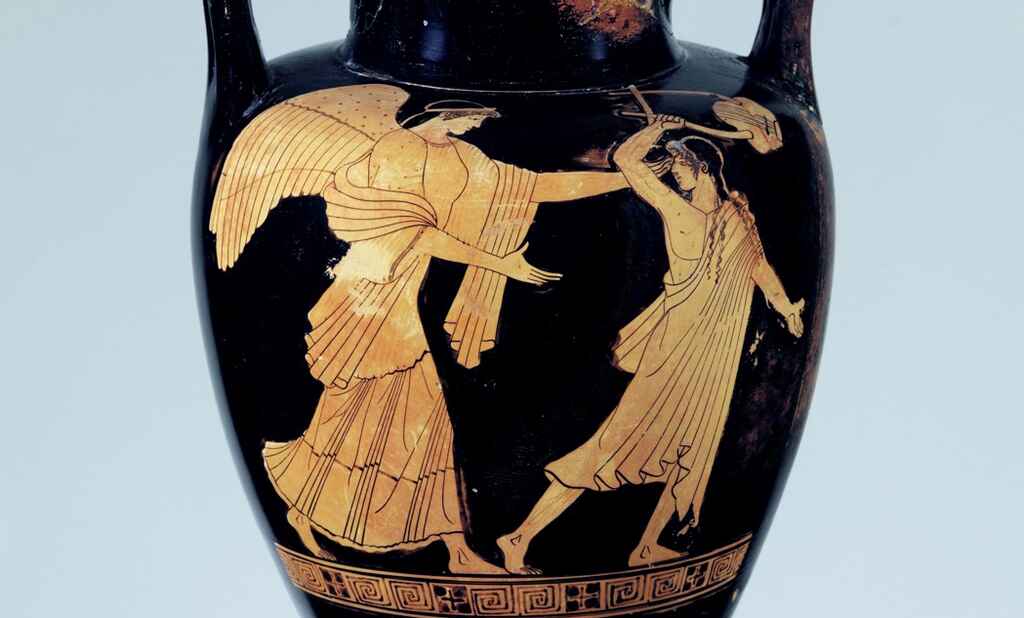
Ever get so excited about that new book you’ve been waiting to get your hands on, or that new game with amazing graphics, that you just want to tell everyone about it? Well, poets have been right there with you for centuries, they even made a poetic form specifically to praise things they think are really amazing. (Though historically speaking, they probably didn’t write about games.)
What a mighty fine thing!
Unlike the previous poetry forms, the ode is a lyrical stanza addressing a specific person, place, thing, or event. In fact, it doesn’t just casually address the thing of choice; it’s written in elaborate praise of said thing. The term ‘ode’ originates from the Ancient Greek ōdḗ (or ‘aoidē’), meaning ‘song’ — likely reflecting the form’s origins as a predominantly musical form.
There are two classic subcategories of ode: Pindaric and Horatian — both of which follow an ABABCDECDE rhyme scheme. However, contemporary odes tend to be more irregular.
What makes a pindaric ode?
Structure: Traditionally separated into three-stanza sections; the strophe (two plus lines repeated as a unit), a metrically harmonious antistrophe (similar to the strophe, but with a thematic reverse), and the epode (concludes the poem thematically, and has a different meter and length to the previous stanzas).
Meter: Characterized by irregular line length.
Rhyme: ABABCDECDE
What makes a Horatian ode?
Structure: Written in a series of couplets or quatrains, thematically surrounding intimate scenes in day-to-day life. Irregular odes may follow any structure.
Meter: Poet's choice, but the rhyme scheme and meter should be consistent throughout.
Rhyme scheme: ABABCDECDE. Irregular odes have no set pattern.
What makes an irregular ode?
Structure: No strict form, verse structure and patterns should be irregular.
Meter: As the title suggests, the meter can be irregular.
Rhyme scheme: Typically rhymed, but the placement of the rhyme is the poet's choice.
Pindaric ode extract: "Ode To Aphrodite" by Sappho
Deathless Aphrodite, throned in flowers,
Daughter of Zeus, O terrible enchantress,
With this sorrow, with this anguish, break my spirit
Lady, not longer!
Hear anew the voice! O hear and listen!
Come, as in that island dawn thou camest,
Billowing in thy yoked car to Sappho
Forth from thy father's
Golden house in pity! ... I remember:
Fleet and fair thy sparrows drew thee, beating
Fast their wings above the dusky harvests,
Down the pale heavens,
Lightning anon! And thou, O blest and brightest,
Smiling with immortal eyelids, asked me:
'Maiden, what betideth thee? Or wherefore
Callest upon me?
Horatian ode extract: "Ode to a Nightingale" by John Keats
My heart aches, and a drowsy numbness pains
My sense, as though of hemlock I had drunk,
Or emptied some dull opiate to the drains
One minute past, and Lethe-wards had sunk:
'Tis not through envy of thy happy lot,
But being too happy in thine happiness,—
That thou, light-winged Dryad of the trees
In some melodious plot
Of beechen green, and shadows numberless,
Singest of summer in full-throated ease.
O, for a draught of vintage! that hath been
Cool'd a long age in the deep-delved earth,
Tasting of Flora and the country green,
Dance, and Provençal song, and sunburnt mirth!
O for a beaker full of the warm South,
Full of the true, the blushful Hippocrene,
With beaded bubbles winking at the brim,
And purple-stained mouth;
That I might drink, and leave the world unseen,
And with thee fade away into the forest dim:
Irregular ode extract: "Ode to the West Wind" by Percy Bysshe Shelle
I
O wild West Wind, thou breath of Autumn's being,
Thou, from whose unseen presence the leaves dead
Are driven, like ghosts from an enchanter fleeing,
Yellow, and black, and pale, and hectic red,
Pestilence-stricken multitudes: O thou,
Who chariotest to their dark wintry bed
The winged seeds, where they lie cold and low,
Each like a corpse within its grave, until
Thine azure sister of the Spring shall blow
Her clarion o'er the dreaming earth, and fill
(Driving sweet buds like flocks to feed in air)
With living hues and odours plain and hill:
Wild Spirit, which art moving everywhere;
Destroyer and preserver; hear, oh hear!
3. Ballad
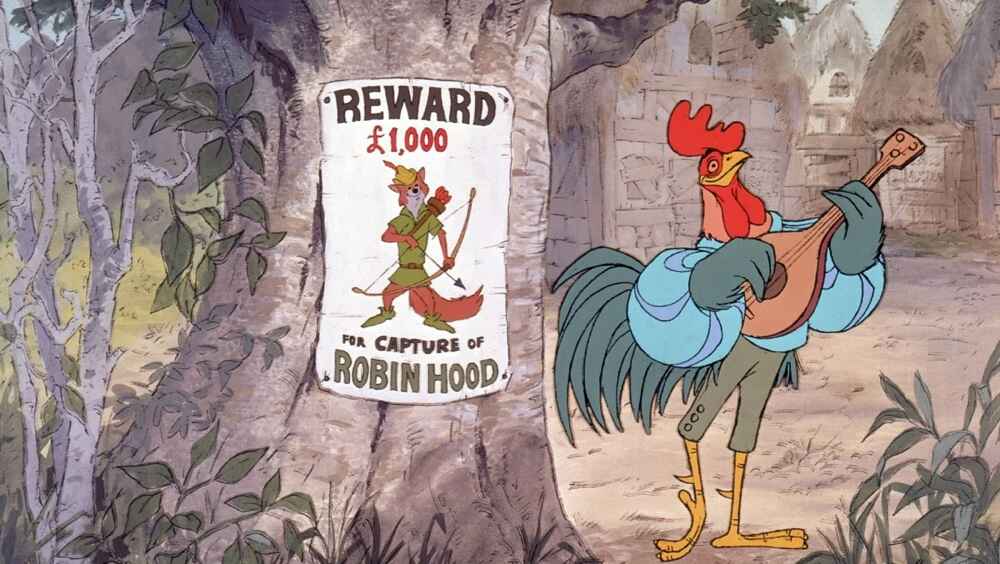
While most modern readers may be more familiar with 80s power ballads than the works of middle-English poets — poetry, culture, and music as we know it today will owe a lot to this form.
Ballads were invented to narrate a story in a memorable way. (Ever heard of the lovable vigilante Robin Hood? You might not have if his legend wasn’t passed down in 14th-century ballads!)
"They'll sing songs about you one day..."
Though popularized by British and Irish bards, the name actually derives from the medieval French chanson balladée (meaning ‘dance songs’) — and it’s not hard to see the semblance between this form’s rhythm and structure and modern-day music:
Lithe and listen, gentleman,
That be of freeborn blood;
I shall you tell of a good yeoman,
His name was Robin Hood.
— A Gest of Robyn Hode, ed. Francis James Child.
While hardly the bread and butter of twenty-first-century writers, 1985's US poet laureate Gwendolyn Brooks has been praised for her mastery of this poetic form. Ballads nowadays can be easily identified by their quatrains (four-line stanzas) and simple, melodic rhyme scheme – designed to fit with musical accompaniment.
What makes a ballad?
Structure: Any length, usually written in quatrains.
Meter: Traditionally, they're written in alternating lines of iambic tetrameter (eight syllables) and iambic trimeter (six syllables).
Rhyme scheme: ABAB or ABCB, occasionally ABABBCBC.
Similar forms in other cultures: Vaar (Punjabi), Corrido (Mexican).
Ballad example: "A Ballad of Hell" by John Davidson
'A letter from my love to-day!
Oh, unexpected, dear appeal!'
She struck a happy tear away,
And broke the crimson seal.
'My love, there is no help on earth,
No help in heaven; the dead-man's bell
Must toll our wedding; our first hearth
Must be the well-paved floor of hell.'
The colour died from out her face,
Her eyes like ghostly candles shone;
She cast dread looks about the place,
Then clenched her teeth and read right on.
'I may not pass the prison door;
Here must I rot from day to day,
Unless I wed whom I abhor,
My cousin, Blanche of Valencay.
4. Elegy

An elegy is a mournful poetic form, the origins of which can be traced back to a combination of Ancient Greek poetics and Old English scriptures from the 11th Century, written to lament a death.
Given the form’s long and rich history, you could point to a plethora of the most well-known poets — such as John Milton, or Walt Whitman — and probably find an elegy somewhere in their work.
You can mourn more than just a person
Of course, this expression of sorrow isn’t exclusive to the death of a person, but also the topic of loss more generally: how we deal with it, the abstract loss of things, or the absence of what once was. Think Thomas Gray’s Elegy Written in a Country Churchyard, in which the speaker wanders through a churchyard (no surprises there) and begins to contemplate his own death, ultimately ending the poem with a passerby reading out an elegy for the narrator himself.
Typically, this form was written in elegiac couplets, but nowadays you’ll usually find them in rhyming quatrains. Of course, if you’re interested in identifying an elegy, or writing one yourself, the most important thing to know is that the rules aren’t strict as long as the content is on-message.
What makes an elegy?
Structure: Can be as long as the poet wants, and is mostly commonly written in couplets or quatrains, but it’s the poet’s choice as long as it’s about death/mourning/etc.
Meter: Iambic pentameter (usually).
Rhyme scheme: Typically ABBA or ABAB, but not strictly.
Similar forms in other cultures: Keening or Caointeoireacht (Gaelic Celtic), Rithā’ (Arabic), Soaz, Noha, and Marsiya (Arabic, Persian, Urdu).
Elegy example: "In Memoriam A.H.H." by Alfred, Lord Tennyson
Our little systems have their day;
They have their day and cease to be:
They are but broken lights of thee,
And thou, O Lord, art more than they.
We have but faith: we cannot know;
For knowledge is of things we see
And yet we trust it comes from thee,
A beam in darkness: let it grow.
5. Epic

The epic poetry form is, as the name might suggest, one of the longest (and oldest) forms of poetry — often book-length. For context, the oldest recorded piece of literature is The Epic of Gilgamesh, which dates back to the Bronze Age between 2500 and 1300 BCE. Though commonly associated with Ancient Greek poets such as Virgil and Homer, almost every classic civilization had its own form of epic. For example, Mahabharata in ancient India and the ancient Persian Shahnameh.
While modern poets seldom write epics, the few that are published (such as Kate Tempest’s 2013 epic Brand New Ancients) are equal parts eye-catching and ripe for critical acclaim when done well.
Epics are long by their very nature
Written in narrative verse, epic poems usually follow the story of a hero or a group of heroes — a famous example of this is, of course, The Odyssey by Homer. Though it’s difficult to define precise rules for writing epic poetry, The Odyssey’s structure is typical with its long stanzas and no rhyme scheme to speak of.
What makes an epic?
In the absence of strict rules, here are a couple of things to look out for:
Standard structure: Often epic (!) in stanza and overall length.
Common features:
- Repetition of words or symbols;
- Enjambement Sentences allow lines to carry over to the next without punctuation, which makes the stanza flow more similar to a real speech;
- Caesura: Mid-line pauses (usually signified by a full-stop or comma) are the poetry equivalent of writing ‘pause for effect’ in a script — helping to add weight to a line, control the pace of the poem, and mimic speech.
Similar forms in other cultures: Kāvya (Indian), Alpamysh (Turkish), Duma (Ukrainian).
Epic poetry extract: "The Odyssey" by Homer (trans. Emily Wilson).
“Hear me, leaders
And chieftains of Phaecia. I will tell you
The promptings of my heart. This foreigner —
I do not know his name — came wandering
from west or east and showed up at my house.
He begs and prays for help to travel on.
Let us assist him, as we have before
with other guests: no visitor has ever
been forced to linger in my house. We always
give them safe passage home. Now let us launch
a ship for her maiden voyage on the water,
and choose a crew of fifty-two, the men
selected as the best, and lash the oars
beside the benches. Then return to shore,
and come to my house. Let the young men hurry
to cook a feast. I will provide supplies,
plenty for everyone. And I invite
you also, lords, to welcome him with me.
Do not refuse! We also must invite
Demodocus, the poet. Gods inspire him,
so any song he chooses to perform
is wonderful to hear.”
6. Alexandrine

The modern English alexandrine is derived from the traditional French alexandrine: one line of twelve syllables, which may be repeated to form a whole poem. What's more, it's not technically a poetic form but a metrical structure — referring to the rhythm and length of a single line.
Though the French alexandrine and the English alexandrine are, by all accounts, pretty similar, there are two key differences when it comes to the caesura and emphasis on syllables, which we'll outline below.
We’ve made sure to include examples of the traditional French alexandrine alongside an English alexandrine. Because French language alexandrines are often translated to iambic pentameter for English speech patterns, we’ve also included French verse by poet and playwright Molière, as well as a faithful English translation of Du Bartas’s French poetry to show you how this form can look in French and English translation.
What makes a French alexandrine?
Structure: A single line adding up to twelve metric syllables.
Meter: Two half-sections (hemistichs) of six syllables, separated by a caesura (pause).
Rhyme scheme: Usually AABB or ABAB when used in a longer poem
Similar forms in other cultures: Trzynastozgłoskowiec (Polish), český alexandrín (Czech), mester de clerecía (Spanish).
What makes an English alexandrine?
Structure: A series of quatrains (four-line stanzas), any length.
Meter: Each line has twelve stresses, with no fixed caesura.
Rhyme scheme: Usually AABB or ABAB when used in a longer poem
Similar forms in other cultures: Trzynastozgłoskowiec (Polish), český alexandrín (Czech), mester de clerecía (Spanish).
Alexandrine extract: "Le Misanthrope" by Molière
Que de son cuisinier il s'est fait un mérite,
et que c'est à sa table à qui l'on rend visite.
Note how there is a natural momentary pause after the fifth syllable of each line. This pause is what's known as a caesura.
Alexandrine extract: "La Sepmaine" by Guillaume de Saluste Du Bartas
Thou that guid’st the course of the flame-bearinge spheares;
The waters fomye bitt, Seas sou’reigne, thou that beares;
That mak’st the Earth to tremble; whose worde onely byndes,
And slackes th’vnruly raynes, to thy swifte postes the wyndes;
Alexandrine extract: "To A Skylark" by Percy Bysshe Shelley
Hail to thee, blithe Spirit!
Bird thou never wert,
That from Heaven, or near it,
Pourest thy full heart
In profuse strains of unpremeditated art.
7. Blank verse
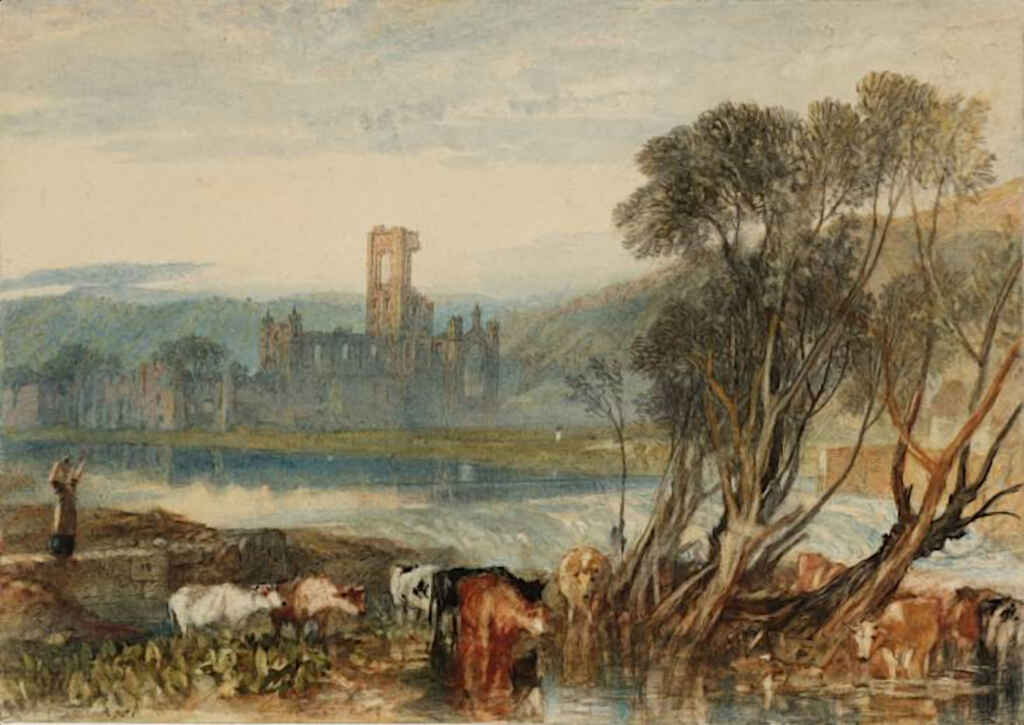
Popular with both old and contemporary writers, blank verse is unrhymed poetry — written most commonly in iambic pentameter. You’ll likely have encountered this form previously; it is commonly found in Shakespeare's plays and poems, chosen perhaps for its similarity to natural English speech. (And, not to mention, it would sound pretty strange if characters spoke in rhymes throughout every play!)
Because of its focus on rhythm above all, blank verse is a great form to look at if you want to delve into meter (what sounds right) and meaning (why, without a rhyme scheme, is one word chosen over another).
What makes a blank verse poem?
Structure: Overall length and stanza length are the poet’s choice.
Meter: Must be in metric verse, usually iambic pentameter.
Rhyme scheme: Unrhymed.
Blank verse example: "Tintern Abbey" by William Wordsworth.
Five years have past; five summers, with the length
Of five long winters! and again I hear
These waters, rolling from their mountain-springs
With a soft inland murmur.—Once again
Do I behold these steep and lofty cliffs,
That on a wild secluded scene impress
Thoughts of more deep seclusion; and connect
The landscape with the quiet of the sky.
The day is come when I again repose
Here, under this dark sycamore, and view
These plots of cottage-ground, these orchard-tufts,
Which at this season, with their unripe fruits,
Are clad in one green hue, and lose themselves
'Mid groves and copses. Once again I see
These hedge-rows, hardly hedge-rows, little lines
Of sportive wood run wild: these pastoral farms,
Green to the very door; and wreaths of smoke
Sent up, in silence, from among the trees!
With some uncertain notice, as might seem
Of vagrant dwellers in the houseless woods,
Or of some Hermit's cave, where by his fire
The Hermit sits alone.
8. Villanelle

The villanelle is a nineteen-line poetic form strictly consisting of five three-line stanzas, ending in a quatrain.
Sadly, this form has nothing to do with a certain loveable villain from BBC’s Killing Eve. In fact, its name can be traced all the way back to the medieval Latin ‘villanus’, meaning ‘farmhand’, reflecting the villanelle’s origin as pastoral folk music — in which a single (usually female) singer would improvise lyrics while a ring of dancers danced around her.
It bears repeating...
The modern villanelle’s heavy use of refrain, in which specific lines of the poem are repeated, definitely reflects its musical roots. This common repetition has made it the favored form for poets who wish to convey obsession — such as with Sylvia Plath’s Mad Girl’s Love Song, in which the narrator obsesses over the loss of a loved one who may or may not have been real.
What makes a villanelle?
Structure: Nineteen lines, structured with five tercets (three-line stanzas) followed by a quatrain.
Meter: No strict meter, though most villanelle's after the twentieth century have been written in pentameter.
Repetitions:
- Line one must repeat in lines six, twelve, and eighteen.
- Line three must repeat in lines nine, fifteen, and nineteen.
Rhyme scheme: ABA, ABA, ABA, ABA, ABA, ABAA.
Villanelle example: "Theocritus" by Oscar Wilde
O Singer of Persephone!
In the dim meadows desolate
Dost thou remember Sicily?
Still through the ivy flits the bee
Where Amaryllis lies in state;
O singer of Persephone!
Simaetha calls on Hecate
And hears the wild dogs at the gate;
Dost thou remember Sicily?
Still by the light and laughing sea
Poor Polypheme bemoans his fate:
O Singer of Persephone!
And still in boyish rivalry
Young Daphnis challenges his mate:
Dost thou remember Sicily?
Slim Lacon keeps a goat for thee,
For thee the jocund shepherds wait,
O Singer of Persephone!
Dost thou remember Sicily?
Villanelle extract: "Mad Girl’s Love Song" by Sylvia Plath
I shut my eyes and all the world drops dead;
I lift my lids and all is born again.
(I think I made you up inside my head.)
The stars go waltzing out in blue and red,
And arbitrary blackness gallops in:
I shut my eyes and all the world drops dead.
9. Free verse
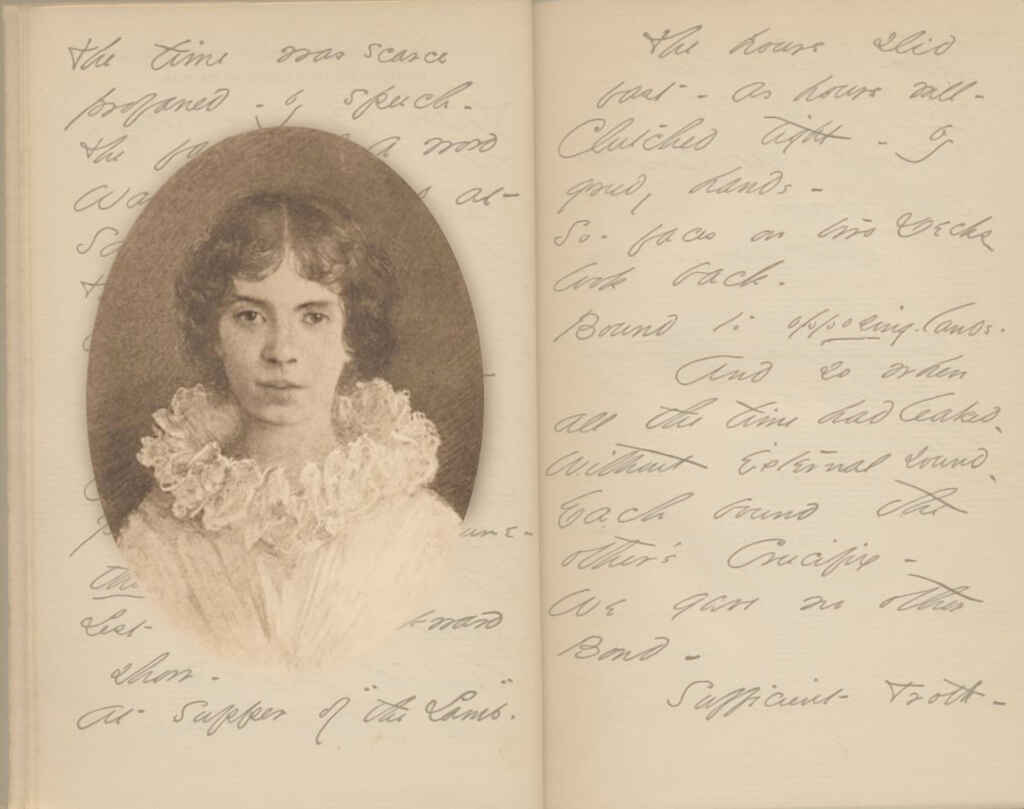
Free verse is the favored poetry form for many contemporary poets, in large part because (as the name implies) they can make their own rules — and break them if they wish. Poets naturally choose to make their own rules most often because, in this form, understanding the effect of punctuation and stanza breaks on how a poem is read is essential.
When writing in free verse, poets (that is if they want to make their poetry public) must be considerate of the reader: how will one rhyme scheme read vs. another? Does this pause emphasize the previous line properly? Are there enough breaks for the reader to catch their breath? These are just some of the questions a poet writing in free verse might ask themselves!
What makes a free verse poem?
Structure: Poet’s choice.
Meter: Anything, really.
Rhyme scheme: Any which way is fine.
Equivalent in other cultures: Japanese haibun.
Free verse example: "Come Slowly, Eden" by Emily Dickinson.
Come slowly – Eden!
Lips unused to Thee –
Bashful – sip thy Jessamines –
As the fainting Bee –
Reaching late his flower,
Round her chamber hums –
Counts his nectars –
Enters – and is lost in Balms.
Note: Free verse always results in interesting book interiors! Check out our post on poetry book layouts for insights from designers and inspiration.
10. Acrostic
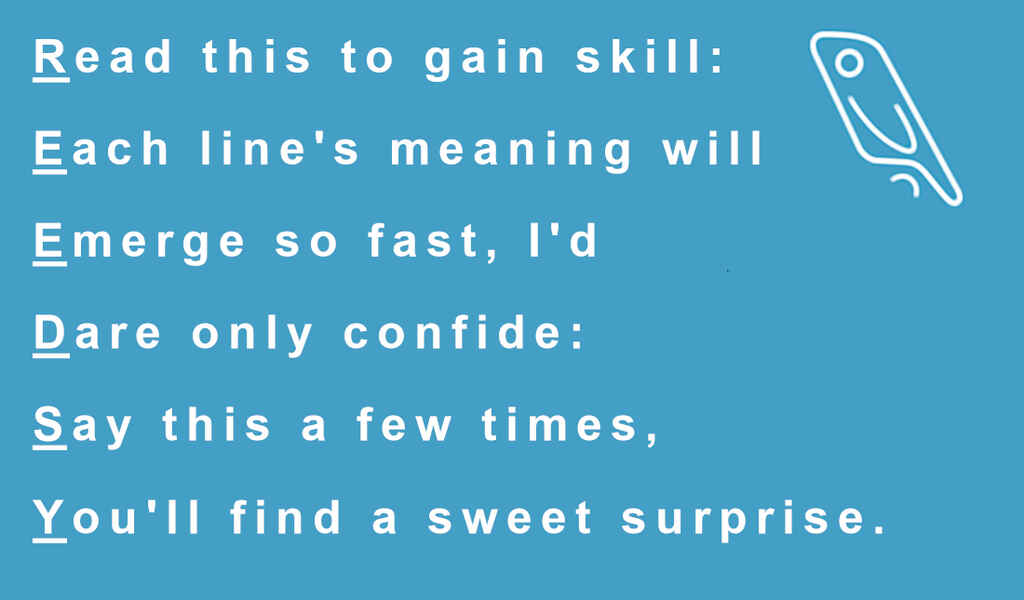
Acrostic poetry spells out a secret meaning, often using the first letter of each new line, stanza, or any other recurring feature. The hidden message could be a word, phrase, or, more commonly, a name — sounds exciting, right? This form was popularised from the high middle ages onwards, with many poets at the time beginning their longer works with a short acrostic spelling their name.
Hidden in plain sight
The beauty of this form is the diversity in how it might be used. Indeed, there have been several instances in recent years of people — such as CEOs, resigning employees, politicians — utilizing prose acrostics in emails and letters (often to convey a political message). You can even find multiple acrostics in the same poem — you might point to Behold, O God! by William Browne, in which you can find three different hidden New Testament verses, as a great example of this.
There aren’t strict rules when it comes to writing this form; you only need to remember that, if there’s a hidden meaning (which is often identified through seemingly random capitalization of letters) then chances are that you’re reading an acrostic.
What makes an acrostic?
Structure: Poet’s choice — just get a hidden meaning in!
Meter: Poet’s choice, but this will probably be determined by the hidden meaning.
Rhyme scheme: Poet’s choice!
Acrostic example: "Elizabeth" by Edgar Allan Poe.
Elizabeth, it surely is most fit
[Logic and common usage so commanding]
In thy own book that first thy name be writ,
Zeno and other sages notwithstanding;
And I have other reasons for so doing
Besides my innate love of contradiction;
Each poet - if a poet - in pursuing
The muses thro' their bowers of Truth or Fiction,
Has studied very little of his part,
Read nothing, written less - in short's a fool
Endued with neither soul, nor sense, nor art,
Being ignorant of one important rule,
Employed in even the theses of the school-
Called - I forget the heathenish Greek name
[Called anything, its meaning is the same]
"Always write first things uppermost in the heart."
11. Haiku
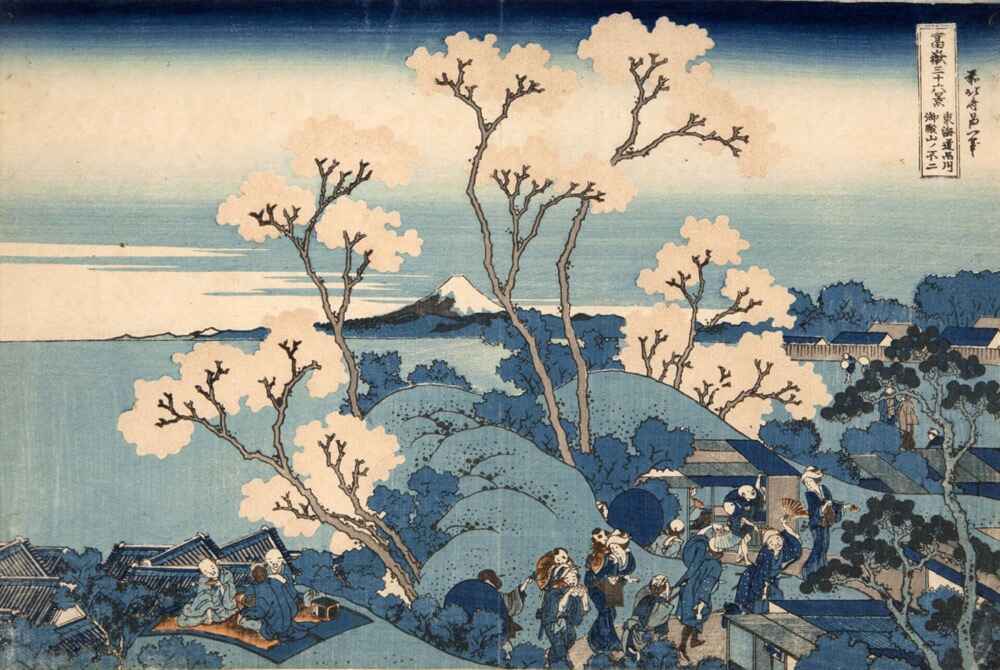
The haiku may often be the first type of poem you encounter; whether you’ve had to write one for school, or you’ve encountered them as Instagram poetry, you’ve probably had some experience with haiku. Though they were traditionally poems about the poet’s geographical and seasonal placement, paying homage to the landscape, nowadays people use the short form for comedic effect.
Short and sweet
The haiku is a three-line poem, with a 5-7-5 syllable structure, originating in seventeenth-century Edo-period Japan. Originally named ‘hokka,’ the haiku is derived from the opening of a longer, collaborative, form of Japanese poetry called renga (or, linked poetry). Notably, most English translations separate haiku into three separate lines, while (romanized) originals are usually one single line separated by caesura.
What makes a haiku?
Structure: Three lines long, with a 5-7-5 syllable structure:
- Line one: five syllables.
- Line two: seven syllables.
- Line three: five syllables.
Meter: Each line must follow the 5-7-5 syllable structure.
Rhyme scheme: N/A.
Haiku example: "The Oak Tree" by Matsuo Bashō
In the original Japanese, romanized:
Kashi no ki no / hana ni kamawanu / sugata kana.
In English, translated by Robert Hass.
The oak tree:
not interested
in cherry blossoms.
12. Epigram
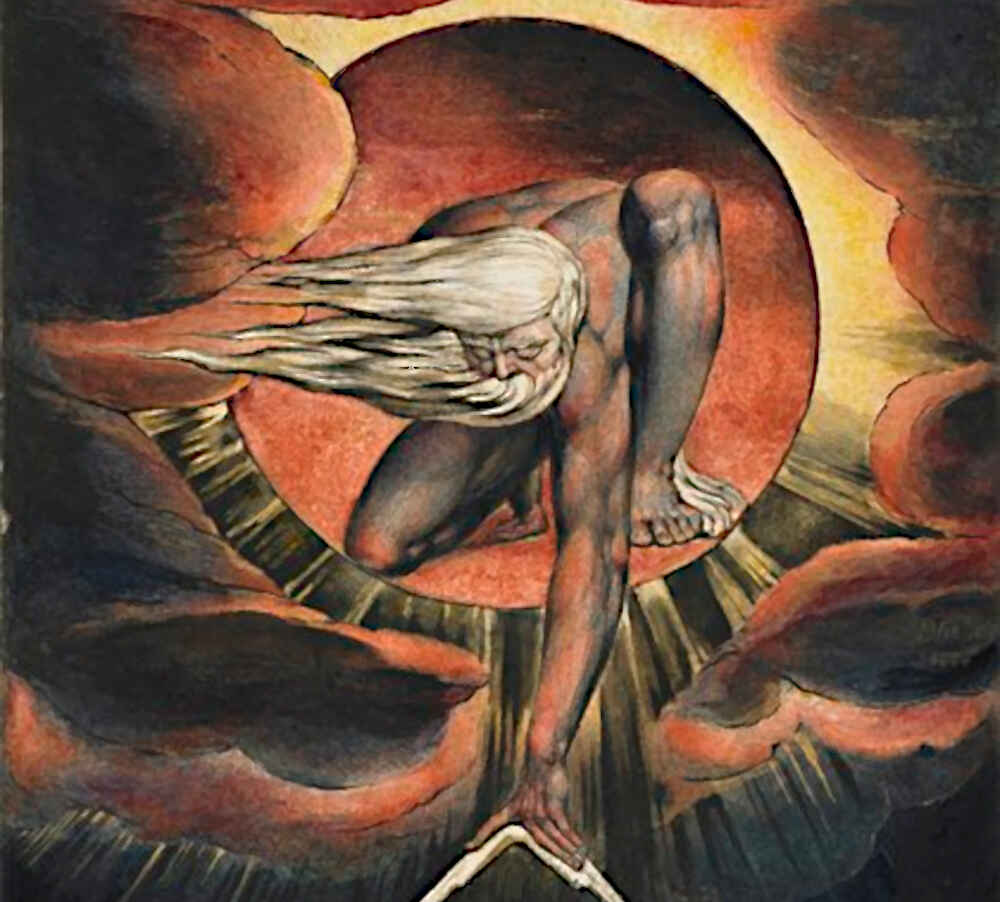
An epigram is a short poetic form that can range from two to four lines long. That said, many poets choose to create longer poems using this form by essentially lacing a number of smaller poems together — the end effect being that each section works well with the next while also standing on its own.
Little poems found in the wild
Though the form was popularized by poets such as Samuel Taylor Coleridge, Voltaire in the sixteenth and seventeenth centuries, you might also point to Ezra Pound or Ogden Nash as more recent writers who favored this style. You might also be interested to know that, unlike other forms, epigrams are not exclusive to poetry. They can be used as a literary device, or in a speech to illustrate complex ideas concisely. (You might point to “an eye for an eye leaves the whole world blind,” a quotation often attributed to Mahatma Gandhi, as a good example of this.)
What makes an epigram?
If you’re looking to spot a poetic epigram, take a look at these simple rules:
Structure: Two to four lines, structured in couplets or four-line quatrains.
Meter: Often in iambic pentameter, but not strictly so.
Rhyme scheme: ABAB (most commonly).
Epigram example: "Auguries of Innocence" by William Blake.
To see a World in a Grain of Sand
And a Heaven in a Wild Flower
Hold Infinity in the palm of your hand
And Eternity in an hour
Epigram example: "Underwoods: Epigram" by Robert Louis Stevenson.
Of all my verse, like not a single line;
But like my title, for it is not mine.
That title from a better man I stole:
Ah, how much better, had I stol'n the whole.
13. Epitaph
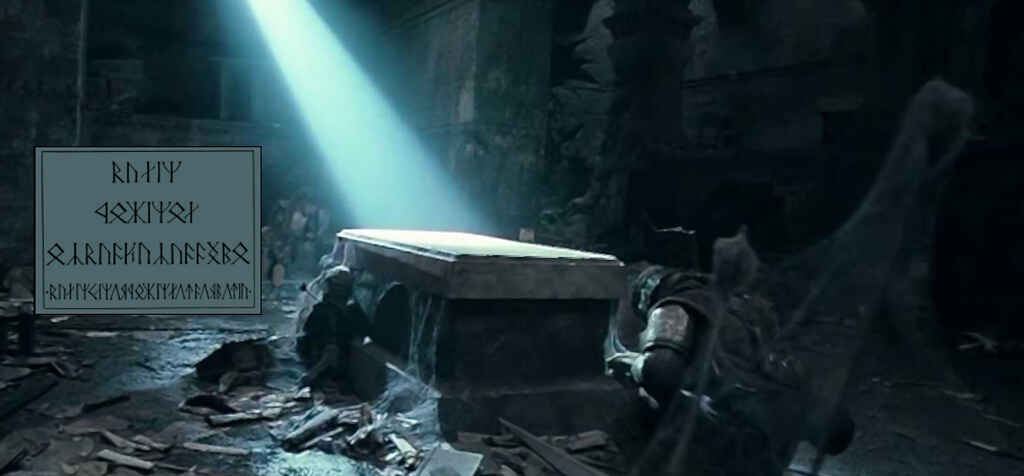
Think of epitaphs as like ‘Elegy Lite’. They’re often found carved onto gravestones so they need to be short unless the intended grave is actually a mausoleum. They also don’t have specific rules to speak of. They date back to the Ancient Egyptians and Greeks — but the English language form used nowadays is derived more closely from the Ancient Roman version, which was less emotive and focused on portraying facts about the deceased.
So long, farewell
That said, modern epitaphs often include riddles, puns on names or professions, and even acrostics (though, it takes some care to know when humor is appropriate). One of the most famous influences for the modern-day epitaph is Robert Burns, who wrote thirty-five epitaphs (for close family, friends, and even himself), many of which were satirical.
What makes an epitaph?
Structure: Poet’s choice!
Meter: Poet’s choice!
Rhyme scheme: Poet’s choice!
Similar forms in other cultures: Jisei (Japanese).
Epitaph example: "Epitaph on my own Friend" by Robert Burns
An honest man here lies at rest
As e'er God with his image blest.
The friend of man, the friend of truth;
The friend of Age, and guide of Youth:
Few hearts like his with virtue warm'd,
Few heads with knowledge so inform'd:
If there's another world, he lives in bliss;
If there is none, he made the best of this.
Epitaph example: "Epitaph" by Edna St. Vincent Millay
Heap not on this mound
Roses that she loved so well;
Why bewilder her with roses,
That she cannot see or smell?
She is happy where she lies
With the dust upon her eyes.
14. Limerick
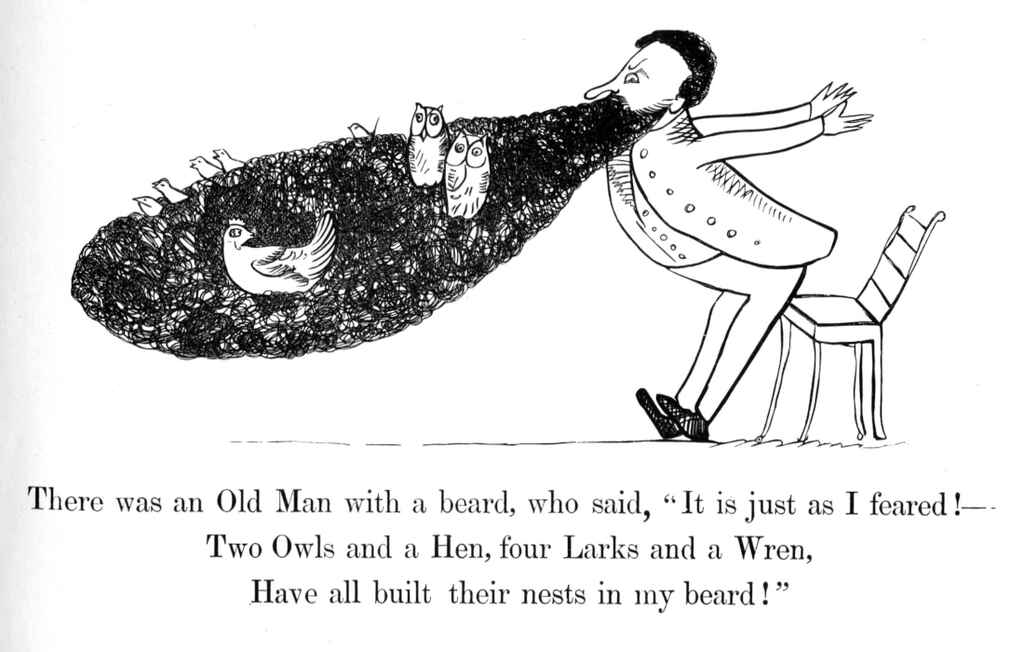
If you’ve ever heard a poem about an old man from Nantucket, then you’ve almost certainly encountered a limerick. These humorous poems, known best for their often rude or shocking punchlines, were popularized by Edward Lear in the nineteenth century.
Part of what enhances the reader’s enjoyment of this form is the distinct AABBA rhyme scheme and rhythm which makes it fun to recite (and a great party trick!). After all, a great joke should feel inevitable and unexpected — the first rhyme of a limerick does this by setting a limit on what the punchline could possibly be, while the last line aims to catch you off-guard despite expectations.
What makes a limerick?
The most important guideline to follow when writing this type of poetry is, of course, to make it funny and memorable. That aside, limericks do have a few rules that make them easy to identify:
Structure: One stanza, five lines.
Meter: The predominant meter is anapestic (two unstressed syllables followed by a stressed syllable). Two long(er) lines of 7-10 syllables each, and two short lines of 5-6 syllables each. The final line should be a punchline.
Rhyme scheme: AABBA.
Note: Though the most common limerick form, following its rise in popularity, would rhyme the same word in the first and last lines, it’s more common now to avoid this, unless for a specific effect.
Limerick example: "Limerick" by Anonymous
The limerick packs laughs anatomical
Into space that is quite economical.
But the good ones I’ve seen
So seldom are clean
And the clean ones so seldom are comical.
Limerick example: "There was an Old Man with a Beard" by Edward Lear
There was an Old Man with a beard,
Who said, "It is just as I feared!—
Two Owls and a Hen, four Larks and a Wren,
Have all built their nests in my beard.
15. Concrete
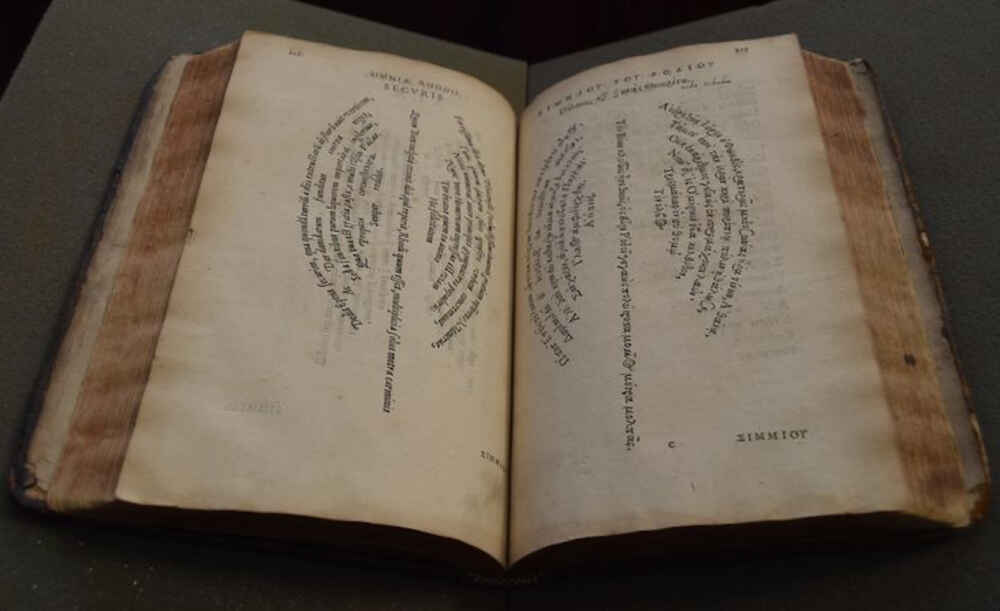
Concrete is given its name because, like concrete in a mold, it changes shape to fit the artist’s purpose. Indeed, it’s written to assume a specific shape on the page in order to reflect the poem’s subject matter. (And, let’s be honest, it’s probably quite an enjoyable form to play around with!)
This form was popular as far back as Greek Alexandria in the 3rd and 4th centuries BCE, and ancient examples of concrete poems (shapes like eggs or hatchets) still remain today. For more recent examples, you might point to George Herman, who was particularly well-known for his concrete poetry — such as in the example below, where the poem’s form mimics the ‘wings’ mentioned in the verse.
What makes a concrete poem?
Structure: How long is a piece of string? That aside, the poem’s physical shape should reflect a theme or symbol.
Meter: Beholden to the poem's shape.
Rhyme scheme: As the poet wishes...
Concrete poetry example: "Easter Wings" by George Herbert.
Lord, who createdst man in wealth and store,
Though foolishly he lost the same,
Decaying more and more,
Till he became
Most poore:
With thee
O let me rise
As larks, harmoniously,
And sing this day thy victories:
Then shall the fall further the flight in me.
My tender age in sorrow did beginner
And still with sicknesses and shame.
Thou didst so punish sinne,
That I became
Most thinne.
With thee
Let me combine,
And feel thy victorie:
For, if I imp my wing on thine,
Affliction shall advance the flight in me.
Now that you have an idea of the various traditional poetry forms mastered by poets of yesteryear, how would you like to write your own? Continue to the next part of this series and learn just that!


